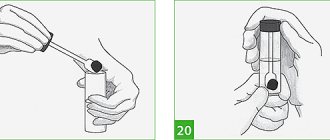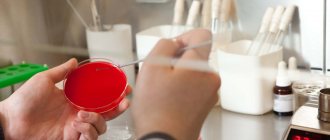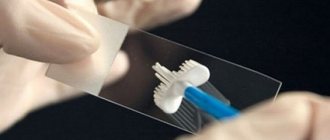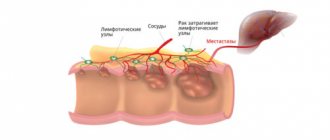What is a coprogram
Human feces are a substance that is released as a result of the digestion process. It comes from the terminal part of the human digestive system - the rectum and consists of undigested food debris, various pigments, water, and intestinal microorganisms. Stool may contain pieces of epithelial tissue and blood cells from the human body.
A coprogram is a study in which the various components of human feces are determined.
What does a general stool analysis for coprogram show in an adult?
Scatological studies are done if it is necessary to identify the causes of various diseases of the gastrointestinal tract. As a rule, coprogram is not the only diagnostic method and is used along with others.
For the pathology of which organs is a coprogram indicated:
- duodenum,
- colon,
- pancreas,
- stomach,
- liver,
- gallbladder and bile ducts.
A coprogram is also prescribed for suspected infectious diseases and helminthic infestations, dysbacteriosis, to determine the causes of severe weight loss, etc.
Indications for use
If a person feels discomfort in the gastrointestinal tract or any pain, then the doctor refers him to a stool coprogram.
There are a number of diseases in which fecal coprogram is provided, such diseases include:
- anal fissures;
- haemorrhoids;
- chronic constipation;
- Crohn's disease;
- pancreatitis;
- stomach and duodenal ulcers;
- liver cirrhosis;
- amoebic dysentery;
Acute intestinal infections:
- Salmonellosis;
- cholera;
- colitis;
- colon polyps;
- malignant tumors;
- anemia and many other pathologies.
If a person experiences abdominal pain, bloating, nausea, bleeding in the stool, heartburn and other symptoms, then this indicates disturbances in the digestive tract, and may be a good reason for prescribing a stool coprogram.
If a person has helminthiasis poisoning or an intestinal infection, then a stool test is prescribed using a coprogram. This method allows you to quickly make a diagnosis and identify all pathogens of the disease.
Fecal coprogram is prescribed to children with suspected worms, various allergic reactions, and also with colic.
Useful video:
We can say that the stool coprogram is indispensable in the diagnosis of diseases of the gastrointestinal tract.
This analysis allows the doctor to make a preliminary diagnosis for the patient and prescribe effective treatment.
Decoding the coprogram
Stool analysis is divided into two types: microscopic and macroscopic. During macroscopic study, the values of the following parameters are determined:
- appearance,
- smell,
- density,
- the presence of blood, mucus, undigested food residues, pus, helminths, pancreatic and gallstones.
During microscopy, stool is checked for the presence of:
- blood,
- squirrel,
- stercobilin,
- bilirubin,
- mucus,
- iodophilic flora,
- detritus,
- fats,
- starch,
- fatty acids and their salts,
- animal connective tissue,
- leukocytes,
- vegetable fiber,
- ammonia,
- pathogenic and conditionally pathogenic microflora.
The decoding includes data on the quantity, presence or absence of certain elements. Some of these elements should be present in the excrement of a healthy person, while other elements indicate the presence of some problems with the digestive tract.
The coprogram also indicates the chemical parameters of excrement, such as acidity (pH).
Scatological research: deciphering indicators:
Scatological examination of feces is a technique that allows you to assess the functioning and condition of the gastrointestinal tract and identify metabolic disorders. The analysis consists of a macroscopic study of the physical and chemical properties of the material, chemical and microscopic. A lot of items include scatological examination of stool. A transcript of the main, significant points is presented in this article.
Consistency and shape
Normally, in an adult, the feces should be dense, shaped, in infants - sticky, viscous. If you see these words next to the “consistency” item, then everything is fine. Scatological examination of feces is a very significant procedure that allows you to identify pathologies in the body. For example, if the stool is doughy, this may indicate problems with the pancreas, loose - about chronic colitis, enteritis, foamy - about irritation of the large intestine, “sheep” - about spasms in the gastrointestinal tract.
Material color
A scatological examination of stool, the deciphering of which is very important for making a correct diagnosis, necessarily takes this parameter into account. The color of the material usually depends on the food a person eats. Light yellow stool indicates the predominance of dairy products in the diet, dark brown stool will be after eating meat, beets can give a reddish tint. If the biomaterial is white, this indicates a blockage of the bile duct, gray - the person has problems with the pancreas, green - liver function is impaired. Normally, the color of stool should be brown.
Smell
It should normally be mild; the smell intensifies if a person’s food is rich in proteins. A sour smell indicates the presence of dyspepsia, a putrid smell indicates ulcerative colitis, stomach problems, etc.
pH reaction
A healthy person has a neutral stool reaction. Everything is fine with your gastrointestinal tract, if this is the indicator contained in the scatological examination. The results are, however, not interpreted separately for each item; the doctor takes into account their combination. If the study reveals a slightly alkaline reaction, that is, disturbances in the functioning of the small intestine, a strongly alkaline environment is characteristic of dyspepsia, while an acidic environment indicates poor absorption of fatty acids.
Protein
If a person is healthy, then a scatological study will confirm this, and the word “absent” will appear in the corresponding column. If there is even a small amount of it, then the doctor has every reason to suspect the presence of gastritis, ulcers, enteritis, duodenitis, polyps or cancer.
hidden blood
Normally it is absent. If a scatological examination reveals its presence, this may indicate conditions such as bleeding, polyps, hemorrhoids, ulcers, etc.
Stercobilin
Normally, the indicators of this product should be in the range from 75 to 350 units. When hemoglobin breaks down in the intestines, the result is stercobilin, which gives stool its characteristic color. If the content of this product is low, we can say that a person has hepatitis or pancreatitis.
Bilirubin
In a healthy person, it is absent in the stool. Bilirubin appears with increased intestinal motility, advanced forms of dysbiosis, and long-term use of certain antibiotics. By the way, if bilirubin and stercobilin are simultaneously detected in the test material, this means that instead of normal microflora, only pathological microflora is present in the intestine.
Mucus and leukocytes
Mucus is a discharge that has a jelly-like consistency. They protect the intestines from irritating substances such as alkalis and acids. In the large intestine, mucus mixes with feces, resulting in a homogeneous substance. If it is present in the feces as a separate component, this indicates an infectious process in the gastrointestinal tract.
There should be no leukocytes in the test material. They are found in dysentery, colon tuberculosis and other pathological conditions.
Muscle fibers and connective tissue
Normally, both indicators should be negative. The presence of muscle fibers is characteristic of gastric dysfunction, ulcerative colitis, constipation, dyspepsia, and increased secretion.
The presence of connective tissue in stool indicates functional pancreatic insufficiency.
Neutral fat and fatty acids
Such substances should also normally be absent. Their appearance indicates pathologies such as poor flow of bile, rapid evacuation of masses from the small intestine, putrefactive dyspepsia, etc.
Conclusion
Coprological research is not an automated process, but the painstaking work of professional laboratory technicians. It should also be noted that feces should be free of iodophilic flora, starch and soap. Get tested, monitor your gastrointestinal tract and be healthy!
www.syl.ru
How to take a stool test
Not all patients know how to properly take a stool test. Before taking the test, you must undergo appropriate preparation. First of all, feces should be collected in a clean container. Special sterile containers sold in pharmacies are best suited for submitting material for coprology. Material cannot be collected in containers similar to matchboxes. If one container becomes dirty, do not wash it or use it again. It would be better to replace it with a new one.
To prepare, you may also need to change your diet. If the doctor prescribes a special diet before the analysis, then it must be followed. As a rule, this occurs if the purpose of the analysis is to detect gastric bleeding.
Avoid eating foods that cause loose stools (or constipation). It is also not recommended to eat foods (such as beets or blueberries) that make the excrement an unnatural color, as this can make it difficult to decipher.
You should also not take certain medications during the preparation period. For example, these are iron and bismuth preparations that color excrement. Prohibited substances also include enterosorbents, primarily activated carbon, which also intensely colors the stool. You should not take antibiotics either - due to the fact that they can change the composition of the intestinal microflora, enzyme preparations. Do not administer drugs rectally (for example, in the form of suppositories). Such recommendations should be followed approximately 2-3 days before collecting the material.
If the patient had an X-ray of the stomach with barium, then the stool coprogram should be postponed for at least a week.
When collecting material, it is necessary to ensure that urine and blood do not get into it. For this reason, you should not take the test for those who have bleeding hemorrhoids, or for women during menstruation. Before collecting material, you must wash your hands with soap. If an infant is taking the test, you cannot collect material from diapers. The correct way to collect material from a child is from plastic film or oilcloth.
Defecation to collect material must be natural; the use of enemas is prohibited.
How much feces is needed? It is enough to hand over a small amount of material - approximately 15-20 g. The container should be filled to no more than a third of its volume.
The material cannot be stored for a long time. Optimally, stool should be donated fresh. However, if this is not possible, for example, if the material is collected in the evening and needs to be taken to the laboratory in the morning, then the material can be placed in the refrigerator. Stool should be stored for no more than 8 hours at a temperature of approximately +5°C. Otherwise, the material will begin to decompose.
Preparing for the study
Before a coprogram, you need to give up antibiotics, exotic fruits and dyes.
In order to prepare for the study, you need to follow simple rules, and then the analysis will be accurate.
Be sure to stop taking antibiotics a week before coprogram, as well as medications that may contain iron and bismuth.
If a person undergoes an X-ray, then the barium content in his body can cause coprogram, so it should not be carried out within 10 days.
Also, a week before the coprogram, you must adhere to a certain diet and not eat any exotic fruits.
For a few days, you need to give up foods that contain coloring substances, such foods include tomatoes, tomato juice, and beets.
It is also necessary to refrain from fatty and fried foods. It is also worth remembering that women should not undergo stool coprogram during menstruation. Having prepared for the study, you can begin collecting stool.
Norms of indicators
The gastrointestinal tract works differently in people of different ages. A person’s diet also leaves its mark. For this reason, the normal values of stool parameters in an adult and an infant are somewhat different.
| Parameter | normal for adults | normal values for infants |
| amount of excrement | 100-200 g | 50 g |
| form | cylindrical, with a predominantly plant-based diet – slightly mushy | mushy |
| consistency | soft, thick | |
| the presence of foreign matter in the stool | only undigested plant fiber | No |
| color | from light brown to dark brown (depending on diet). May appear black, reddish or greenish when consuming foods containing coloring pigments | yellowish-green or yellowish-brown (depending on the type of feeding - breast or artificial) |
| smell | typical fecal odor | sourish |
| acidity (pH) | neutral (7.0-7.5) | sour (5.0-6.0) |
| mucus in stool | No | No |
| blood in stool | No | No |
| worms in stool | No | No |
| leftover food in stool | small amount of undigested animal fiber | No |
| indigestible types of fiber in stool | present | may be present if the baby's diet includes them |
| starch and other digestible polysaccharides in feces | No | No |
| fats, fatty acid salts, fatty acids in feces | in small quantities or absent | none |
| leukocytes in stool | single or absent | single |
| red blood cells in stool | none | none |
| cholesterol crystals in stool | There is | may be present |
| microorganisms | There is | There is |











